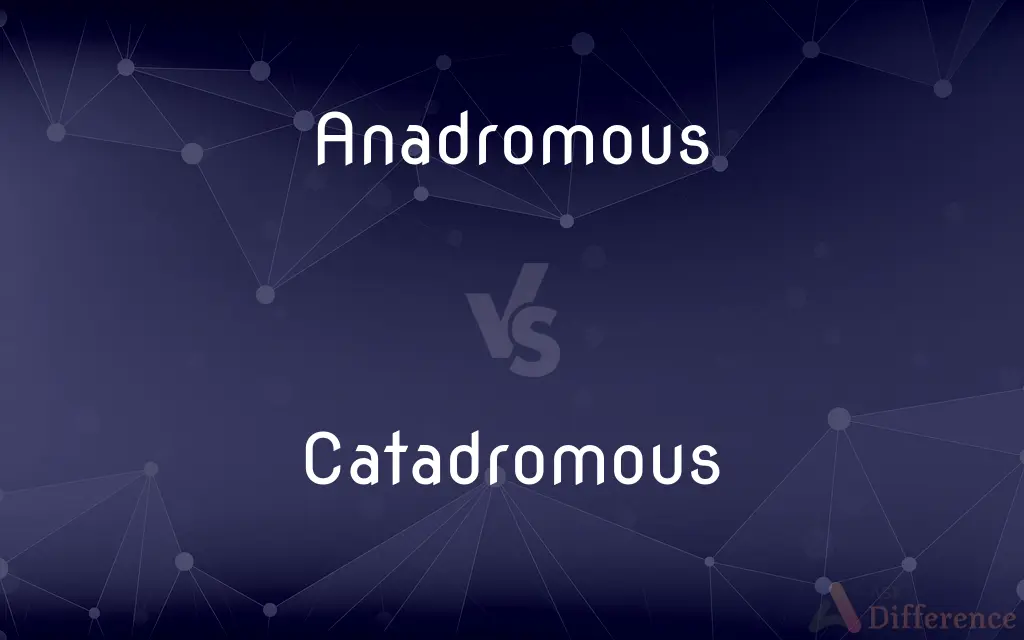Anadromous vs. Catadromous — What's the Difference?
Edited by Tayyaba Rehman — By Maham Liaqat — Updated on April 2, 2024
Anadromous fish migrate from the sea to freshwater to spawn, offering ecological benefits like nutrient transfer, whereas catadromous fish do the opposite, moving from freshwater to the sea to spawn, contributing to genetic diversity.

Difference Between Anadromous and Catadromous
Table of Contents
ADVERTISEMENT
Key Differences
Anadromous fish, such as salmon and steelhead trout, spend most of their adult lives in the ocean but return to freshwater rivers and streams to spawn. This migration pattern enriches freshwater ecosystems by bringing ocean nutrients inland, which supports a wide range of species. On the other hand, catadromous fish like the European eel migrate from freshwater habitats to the ocean to spawn, often traveling vast distances. Their migration contributes to the genetic diversity and resilience of marine populations by mixing genes across different freshwater environments.
The ecological impact of anadromous fish is significant in freshwater ecosystems. By dying after spawning, they provide a substantial nutrient boost to riverine environments, supporting both aquatic and terrestrial food webs. In contrast, catadromous fish impact marine ecosystems by returning nutrients and energy from freshwater habitats to the ocean, where they spawn and die, thus supporting deep-sea communities.
Predation pressures differ markedly between the two life strategies. Anadromous species face increased predation in freshwater environments, especially from birds and mammals, as they often spawn in shallow waters. Conversely, catadromous fish encounter their most significant predation risks in the ocean, where a wider range of predators exists, highlighting the adaptability required for survival in their respective migrations.
The conservation issues surrounding these migratory patterns are complex. Anadromous fish are highly susceptible to freshwater habitat degradation and barriers like dams that impede their spawning migrations. Catadromous species face challenges in both freshwater and marine environments, including pollution and overfishing, especially as juveniles in freshwater and adults in marine spawning grounds.
Human cultural and economic impacts are also noteworthy. Anadromous species, particularly salmon, hold significant cultural value for many indigenous communities and are vital for commercial fisheries. Catadromous fish, such as eels, are culturally significant in some regions and provide important economic benefits through commercial fishing, despite their more complex life cycles.
ADVERTISEMENT
Comparison Chart
Migration Direction
Sea to Freshwater
Freshwater to Sea
Spawning Location
Freshwater
Sea
Ecological Impact
Nutrient transfer to freshwater
Nutrient transfer to the sea
Predation Risk
Higher in freshwater
Higher in the ocean
Conservation Challenges
Habitat degradation, barriers
Pollution, overfishing
Cultural/Economic Impact
High, especially for indigenous communities and commercial fisheries
Culturally significant, important for commercial fishing in some regions
Compare with Definitions
Anadromous
Fish migrating from the sea to freshwater to spawn.
Salmon are famous for their anadromous migration, returning to their birthplace to spawn.
Catadromous
Fish migrating from freshwater to the sea to spawn.
European eels undertake a long migration to the Sargasso Sea to spawn.
Anadromous
Supports freshwater ecosystems with ocean nutrients.
The nutrient influx from anadromous fish spawning supports numerous riverine species.
Catadromous
Contributes to marine genetic diversity.
Catadromous fish migrations help mix genetic material across distant ecosystems.
Anadromous
Important for commercial fisheries.
The fishing industry relies heavily on anadromous species like salmon.
Catadromous
Vulnerable to environmental challenges.
Eels face numerous hazards, from freshwater pollution to oceanic overfishing.
Anadromous
Faces threats from freshwater habitat changes.
Dams and pollution significantly impact anadromous fish populations.
Catadromous
Economically important in specific regions.
Eel fishing is a lucrative industry in parts of Europe and Asia.
Anadromous
Culturally significant to indigenous peoples.
Salmon runs are a vital cultural and subsistence resource for many indigenous communities.
Catadromous
Has a complex life cycle involving both environments.
The life cycle of catadromous fish spans both freshwater and marine habitats.
Anadromous
Migrating up rivers from the sea to breed in fresh water. Used of fish.
Catadromous
Living in fresh water but migrating to marine waters to breed. Used of fish.
Anadromous
(of a migratory fish) That lives in the sea and breeds in fresh water.
Shads and most species of salmon are anadromous.
Catadromous
Living in fresh water as an adult, but breeding in the sea.
Anadromous
(botany) Of a fern in which the first veins in a frond segment are produced towards the apex of the frond.
Catadromous
(botany) Of a fern in which the first veins in a frond segment are produced towards the base of the frond.
Anadromous
Ascending rivers from the sea, at certain seasons, for breeding, as the salmon, shad, etc.
Catadromous
Having the lowest inferior segment of a pinna nearer the rachis than the lowest superior one; - said of a mode of branching in ferns, and opposed to anadromous.
Anadromous
Tending upwards; - said of terns in which the lowest secondary segments are on the upper side of the branch of the central stem.
Catadromous
Living in fresh water, and going to the sea to spawn; - opposed to anadromous, and said of the eel.
Anadromous
(used of fish) migratory between fresh and salt waters
Catadromous
(used of fish) migratory between fresh and salt waters
Common Curiosities
What challenges do anadromous fish face?
They are vulnerable to freshwater habitat degradation, pollution, and barriers like dams that impede migration.
Why do anadromous fish migrate to freshwater to spawn?
They migrate to take advantage of safer spawning grounds and nutrient-rich freshwater environments.
How do catadromous fish contribute to marine ecosystems?
By migrating to the sea to spawn, they transfer nutrients and energy from freshwater to marine ecosystems.
What role do catadromous fish play in human culture?
Catadromous fish, like eels, are culturally significant and provide economic benefits through fishing in certain regions.
What defines an anadromous fish?
Anadromous fish migrate from the sea to freshwater to spawn, contributing nutrients to river ecosystems.
How do human activities impact these migratory fish?
Pollution, habitat destruction, and barriers like dams for anadromous fish, and overfishing and environmental degradation for catadromous fish, pose significant threats.
What defines a catadromous fish?
Catadromous fish migrate from freshwater to the sea to spawn, enhancing genetic diversity in marine populations.
How important are anadromous fish to human communities?
They have significant cultural and economic importance, especially for indigenous peoples and commercial fisheries.
What are the conservation concerns for catadromous fish?
They face challenges from environmental pollution, habitat loss in freshwater, and overfishing in marine spawning areas.
Can anadromous and catadromous fish be found in the same regions?
While their migratory patterns are opposite, both types of fish can coexist in regions where freshwater and marine environments intersect.
Share Your Discovery

Previous Comparison
Old vs. Elderly
Next Comparison
Slang vs. TongueAuthor Spotlight
Written by
Maham LiaqatEdited by
Tayyaba RehmanTayyaba Rehman is a distinguished writer, currently serving as a primary contributor to askdifference.com. As a researcher in semantics and etymology, Tayyaba's passion for the complexity of languages and their distinctions has found a perfect home on the platform. Tayyaba delves into the intricacies of language, distinguishing between commonly confused words and phrases, thereby providing clarity for readers worldwide.















































